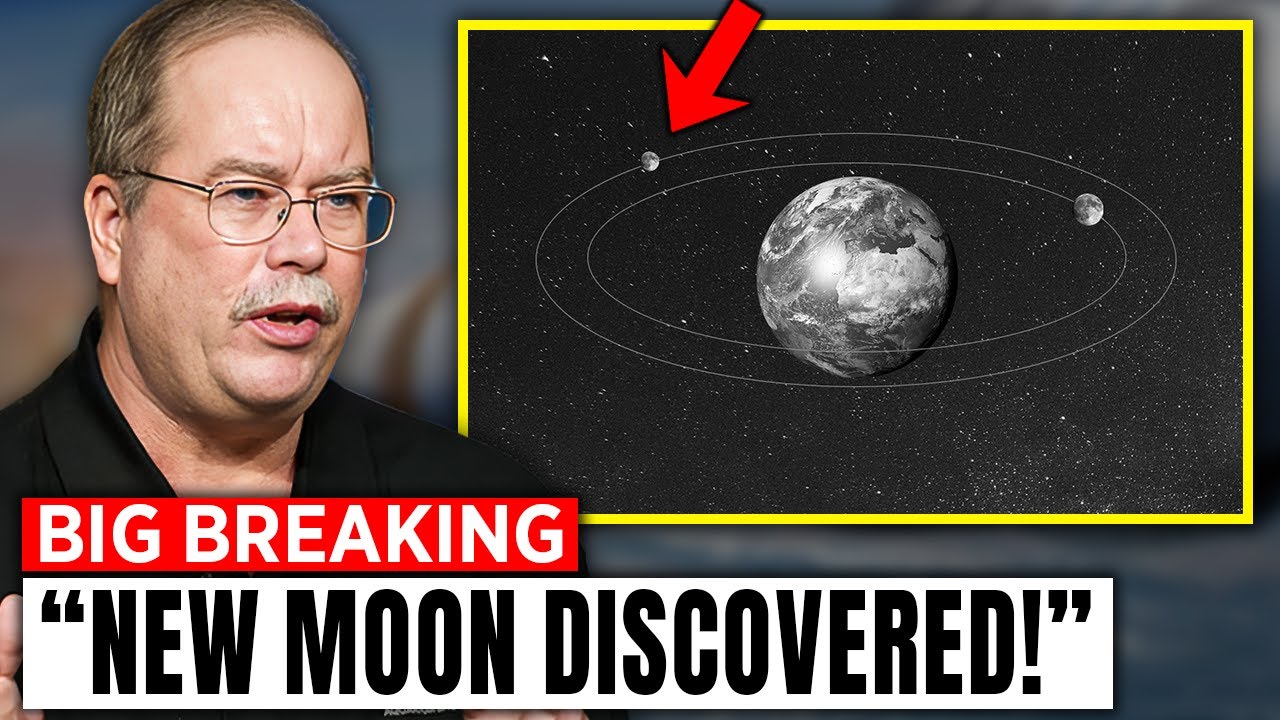🌑 A New Moon Discovered—and It’s Freaking Scientists Out! 🌑
Out in the icy depths of our solar system, a tiny new moon has been spotted, but there’s something about it that’s sending chills down astronomers’ spines. What makes this mysterious orb so terrifying? The truth might keep you up at night. 😱
👉 Click to uncover the eerie secrets of this cosmic find!

A New Moon Around Uranus: Why Scientists Call It Scarier Than Expected
On August 20, 2025, astronomers announced a startling discovery: a new moon orbiting Uranus, bringing the planet’s total to 29 known satellites. Detected by NASA’s James Webb Space Telescope (JWST), this tiny moon, tentatively named S/2025 U1, is just six miles wide—small enough to walk across in a couple of hours. Yet, its discovery has sent ripples through the scientific community, with some describing it as “scarier than expected.” Why does this faint, fleeting object evoke such unease? Let’s dive into the details of S/2025 U1, the mysteries of Uranus’s chaotic system, and what makes this find so unsettling.
The Discovery of S/2025 U1
The story begins with the JWST, a $10 billion marvel launched in 2021, designed to peer into the universe’s farthest reaches. On February 2, 2025, a team led by Maryame El Moutamid at the Southwest Research Institute (SwRI) in Colorado used JWST’s Near-Infrared Camera (NIRCam) to capture ten 40-minute exposures of Uranus. Among the planet’s rings and 28 known moons, they spotted a faint speck moving in a near-circular orbit, 35,000 miles from Uranus’s center, between the moons Ophelia and Bianca, just outside the bright Epsilon ring []. Dubbed S/2025 U1, this moon—estimated at 10 kilometers in diameter—is the smallest and faintest Uranian moon ever detected, invisible to Voyager 2 during its 1986 flyby [].
The discovery, announced via NASA and Scientific American, wasn’t just a triumph of technology; it hinted at deeper mysteries. Uranus, the seventh planet, is an ice giant with a tilted axis, faint rings, and a complex system of small moons. S/2025 U1’s size and location make it a puzzle piece in a system that’s already baffling scientists. But what’s so “scary” about this tiny moon? The answer lies in what it reveals about Uranus—and the unsettling questions it raises.
Why “Scarier Than Expected”?
The “scarier” label likely stems from the moon’s implications for Uranus’s chaotic history and its eerie elusiveness. Matthew Tiscareno of the SETI Institute, a team member, noted that Uranus has more small inner moons than any other planet, with “complex inter-relationships” suggesting a turbulent past []. S/2025 U1, smaller and fainter than any previously known moon, hints that even more tiny satellites may lurk undetected, blurring the line between moons and rings []. This raises a chilling possibility: our understanding of Uranus’s system is far less complete than we thought, and its chaotic evolution could mirror unstable systems around distant exoplanets [].
The moon’s proximity to the Epsilon ring, yet not acting as a “shepherd” to shape it, defies expectations []. Its faintness—described by Mark Showalter as like “a fly next to a car headlight”—required JWST’s unparalleled sensitivity to detect []. This suggests other unseen objects could be hiding, evading even our best telescopes. The idea of a system teeming with invisible moons and ring fragments, orbiting a planet we barely understand, feels unsettling, almost cosmic horror-like. Add to that Uranus’s eerie pale-blue hue, tilted 98-degree axis, and extreme environment—temperatures plunging to -224°C—and S/2025 U1’s discovery feels like stumbling upon a ghost in a haunted house.
Uranus: The Enigmatic Ice Giant
To grasp why S/2025 U1 is so intriguing, we need to understand Uranus. Discovered in 1781 by William Herschel, it’s a gas giant with an icy mantle of water, ammonia, and methane, giving it a ghostly cyan glow. Its extreme tilt, likely caused by a massive ancient collision, creates bizarre seasons—each pole gets 42 years of continuous sunlight or darkness []. Voyager 2’s 1986 flyby revealed a planet with faint rings, 11 new moons (bringing the total to 15 then), and a magnetic field misaligned with its rotation, unlike any other planet []. Since then, Hubble and ground-based telescopes have pushed the moon count to 28 before S/2025 U1 [].
Uranus’s rings and moons form a dynamic system. The rings, unlike Saturn’s dense bands, are sparse, like “hula hoops” with gaps, possibly sculpted by tiny moons []. S/2025 U1’s location near the Epsilon ring suggests it could influence this system, but its small size and non-shepherd role complicate models of ring-moon interactions []. El Moutamid told The New York Times that more moons likely exist, too faint for current detection, hinting at a “chaotic history” where collisions and gravitational tugs reshaped the system [].
The Science Behind the Discovery
JWST’s NIRCam was key to spotting S/2025 U1. Designed to see faint galaxies, its infrared sensitivity pierced Uranus’s bright glare to reveal the moon’s dim signal []. The team took a series of long-exposure images over six hours, tracking the speck’s motion to confirm its orbit []. Unlike larger moons like Titania or Oberon, S/2025 U1 is so small it was missed by Voyager 2, whose cameras couldn’t resolve such faint objects near the planet’s rings []. Its estimated six-mile diameter assumes reflectivity similar to other Uranian moons, but its true composition remains unknown [].
The discovery underscores JWST’s power. As Heidi Hammel, a planetary scientist, told Scientific American, its cameras are “vastly more sensitive” than any prior telescope, capable of spotting faint objects near bright ones []. This raises hope for finding even smaller moons, but also fuels the “scary” narrative: if we’ve missed something this close to Uranus, what else is out there, in our solar system or beyond?
The Cultural and Scientific Implications
The “scarier than expected” label taps into our fascination with the unknown. Uranus, one of the least explored planets, is a cipher—Voyager 2’s brief flyby remains our only close-up data. Its moons, named for Shakespearean characters, evoke a poetic mystique, and S/2025 U1’s discovery adds to this allure. On X, users speculated about its “eerie” implications, with one calling it “a ghost moon haunting Uranus’s rings” []. The idea of a hidden, chaotic system resonates with sci-fi tropes, from 2001: A Space Odyssey to Interstellar, where the cosmos holds unsettling secrets.
Scientifically, S/2025 U1 could unlock clues about Uranus’s evolution. Its orbit, in the planet’s equatorial plane, suggests it formed in place, not captured like some outer moons []. Studying its interactions with nearby rings and moons could reveal how Uranus’s system stabilized after ancient collisions []. El Moutamid told Space.com that Uranus is a “close analog” for exoplanets, meaning insights here could inform our search for habitable worlds []. Yet, the moon’s small size and faintness make it a challenge to study, requiring future missions like the proposed Uranus Orbiter and Probe, slated for 2044 [].
Why the Fear Factor?
The “scary” aspect isn’t just hype. Uranus’s system challenges our assumptions. Its rings and moons suggest a violent past, possibly involving shattered satellites or cosmic impacts []. S/2025 U1’s discovery implies more hidden objects, raising questions about stability. Could these moons collide, disrupting the rings? Tiscareno noted their “complex inter-relationships” hint at a system where small changes could have big effects []. This unpredictability, combined with Uranus’s alien environment—methane clouds, extreme cold, and a wonky magnetic field—feels like a cosmic wildcard.
Moreover, the discovery highlights how little we know. As New Scientist reported, detecting such a faint moon shows we’re “at the edge” of our technological limits []. If S/2025 U1 evaded Voyager 2 and earlier telescopes, what else have we missed? This uncertainty, coupled with Uranus’s isolation—1.8 billion miles away—evokes a sense of cosmic dread, as if we’re peering into a void that’s staring back.
The Future: More Moons, More Mysteries
The discovery of S/2025 U1 isn’t the end. El Moutamid and Showalter believe more moons await, possibly smaller and fainter, requiring JWST or future missions to find []. The proposed Uranus Orbiter, if approved, could map the system in detail, revealing how moons like S/2025 U1 shape the rings []. Until then, astronomers will analyze JWST data to study its orbit and composition, hoping to name it after a Shakespearean character, per tradition [].
Conclusion: A Haunting Cosmic Find
S/2025 U1, a tiny moon orbiting Uranus, is more than a scientific footnote—it’s a window into a chaotic, mysterious system that challenges our understanding. Its “scary” label reflects not just its elusiveness but the unsettling reality that our solar system still holds secrets. From Uranus’s violent past to the possibility of unseen moons, this discovery reminds us how vast and unpredictable the cosmos is.
As we gaze at this pale-blue giant, 1.8 billion miles away, S/2025 U1 is a humbling reminder: even in our backyard, the universe surprises us. Whether it’s a harbinger of chaos or just another moon, it’s sparked our curiosity and fear in equal measure. Let’s keep watching, wondering, and exploring—what else is out there, waiting to be found?





